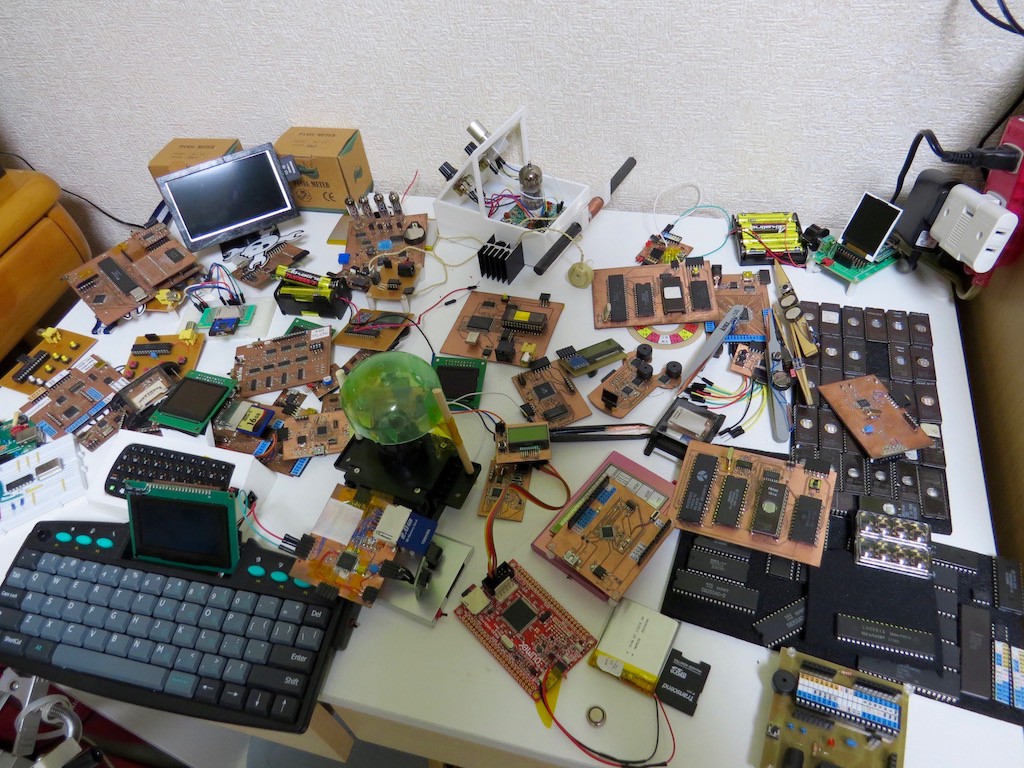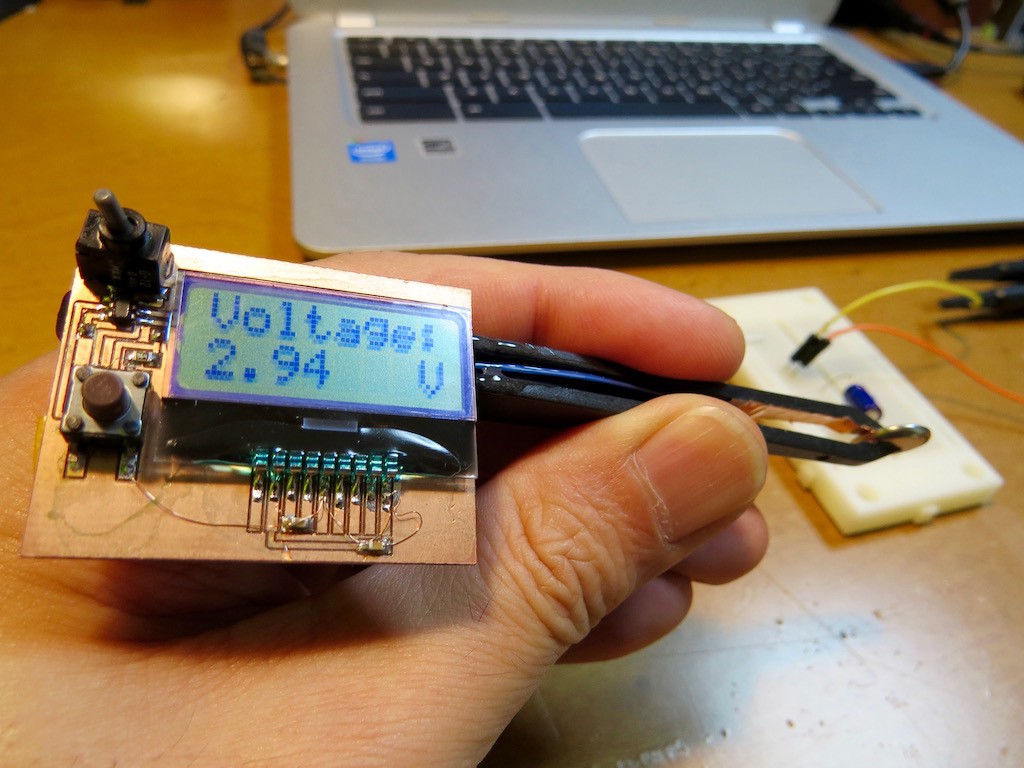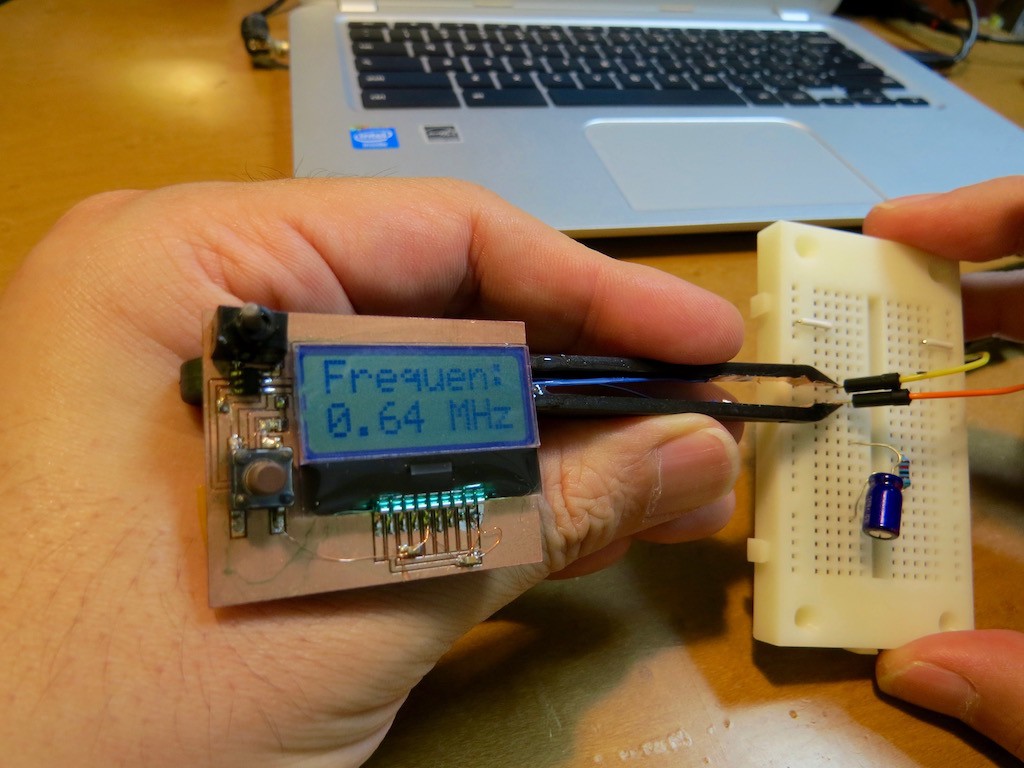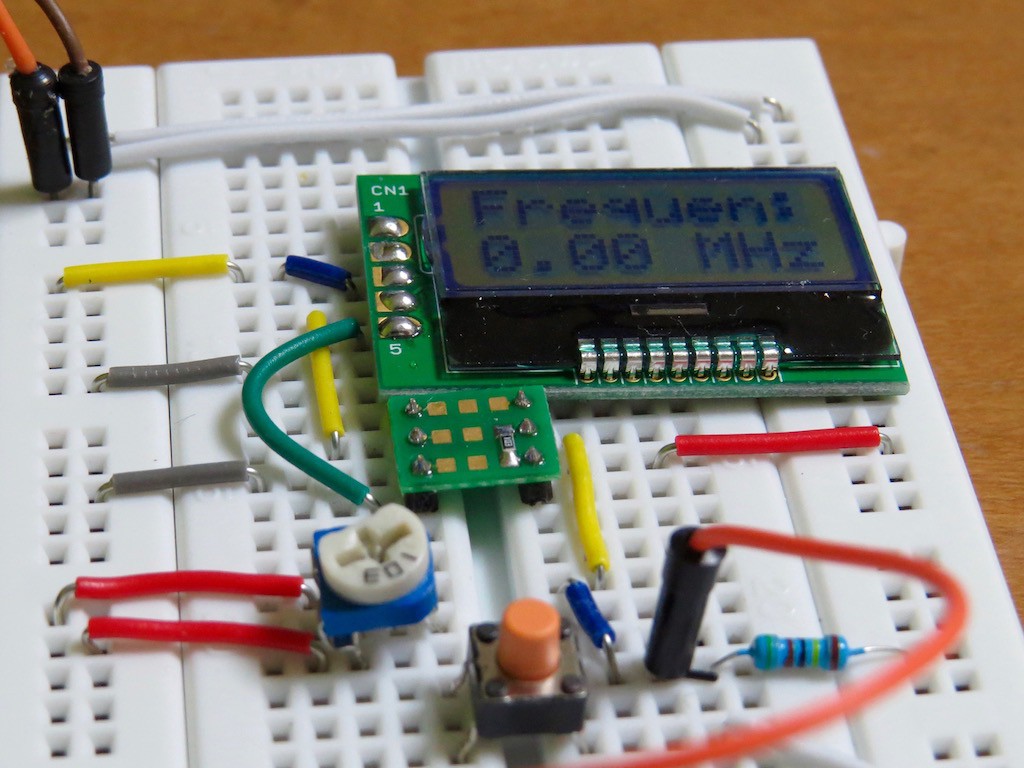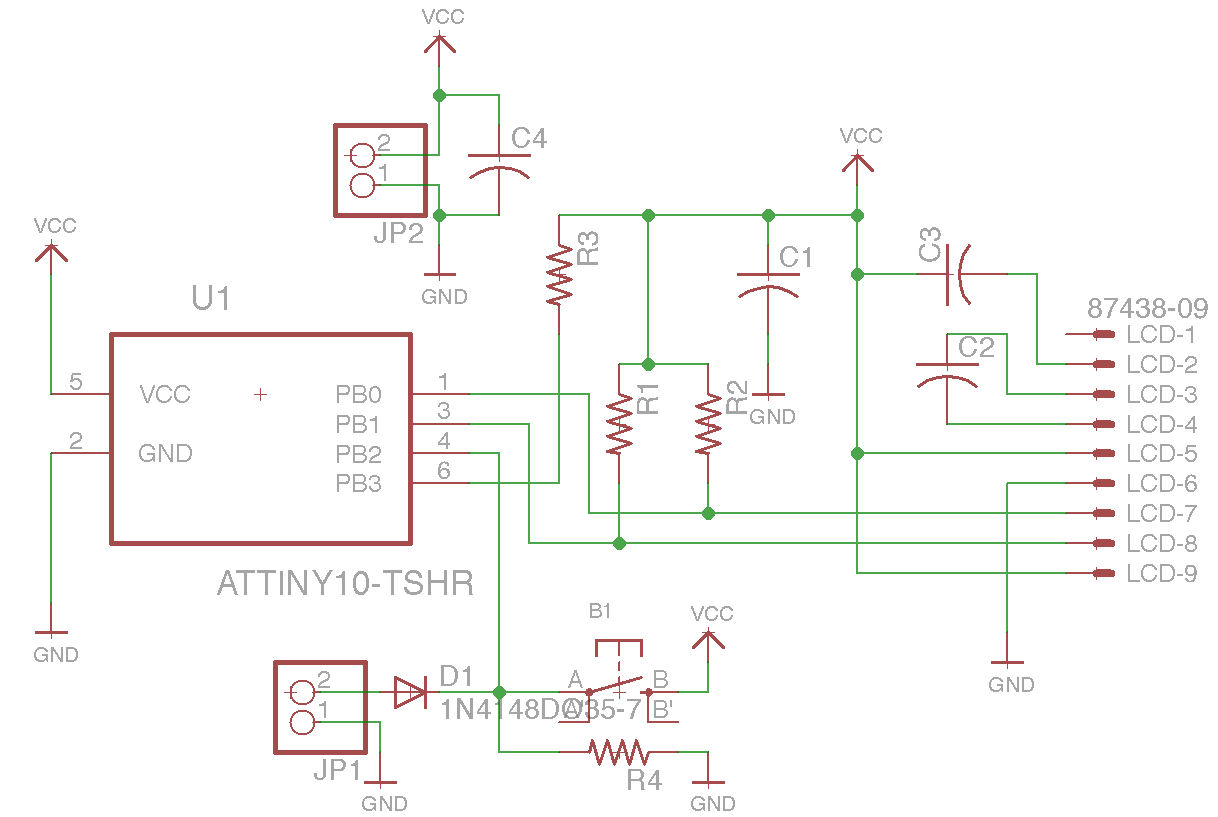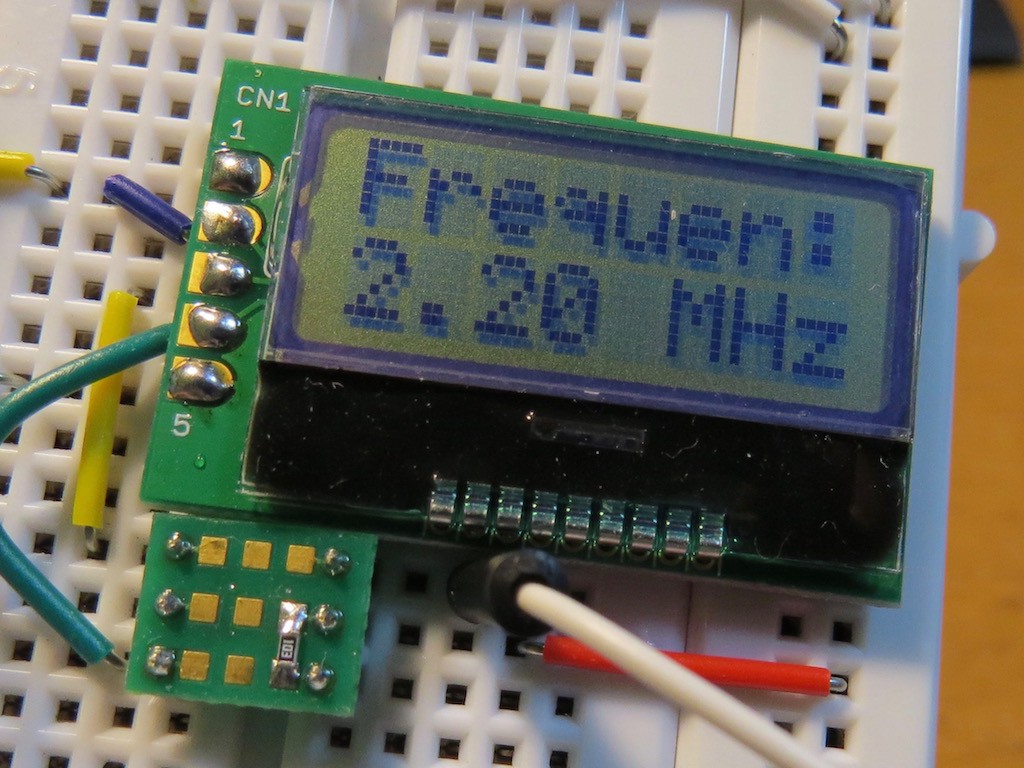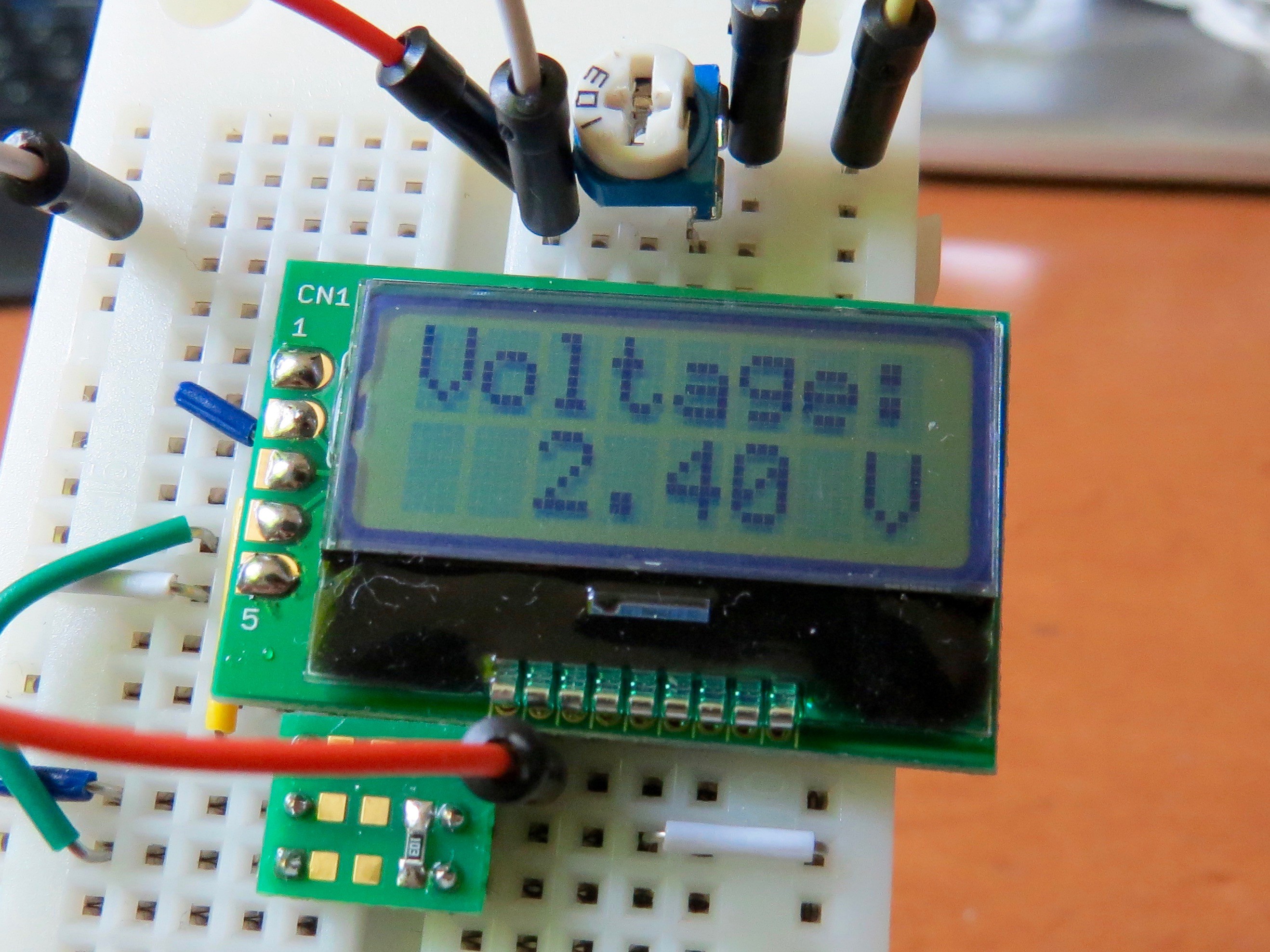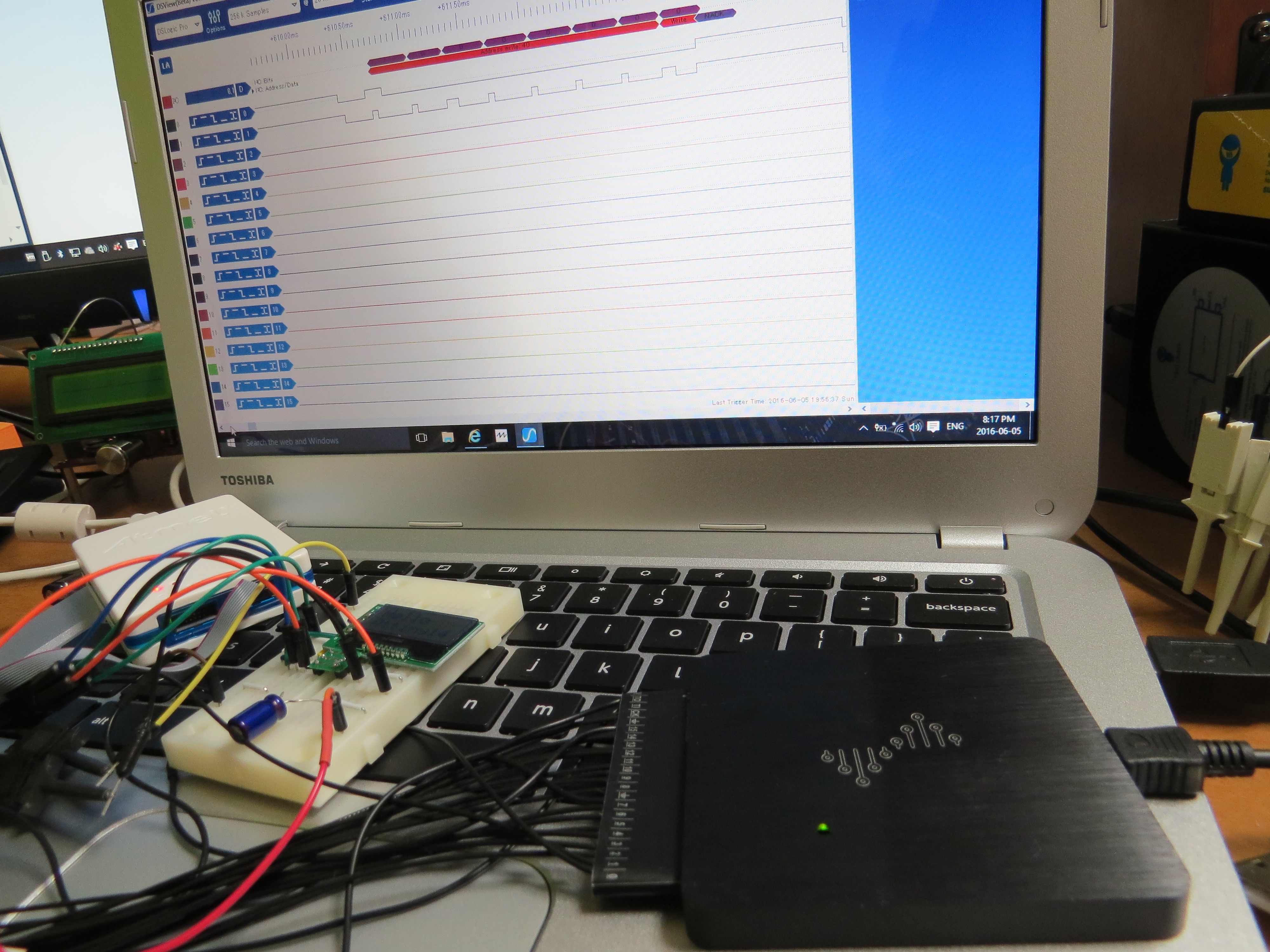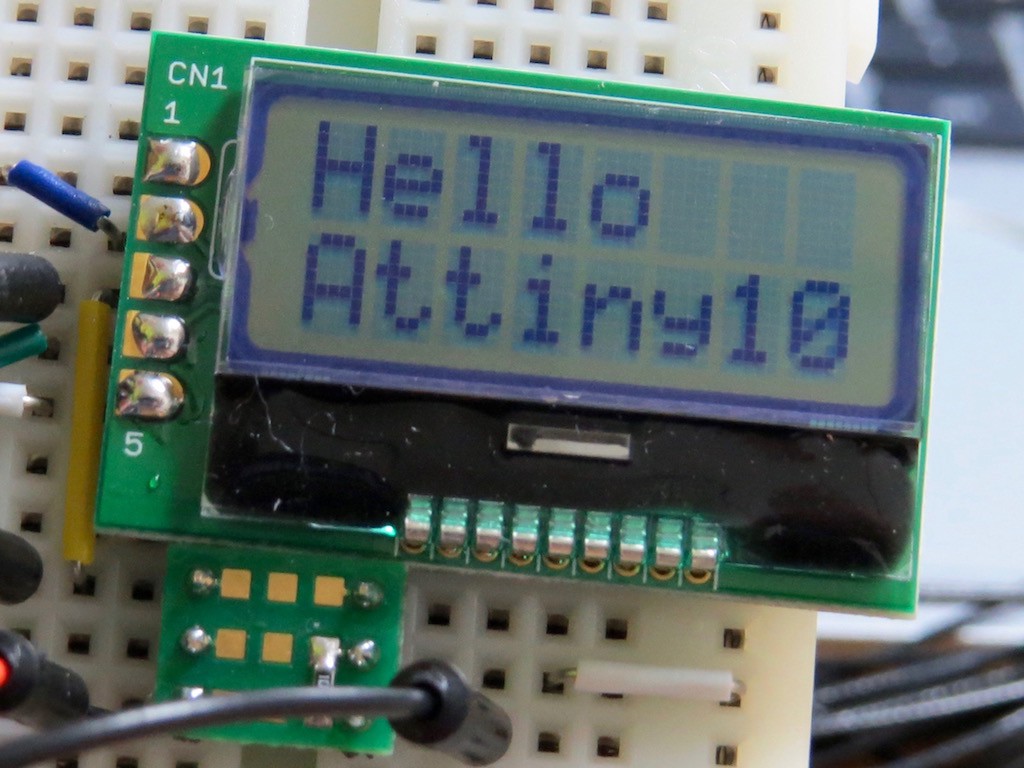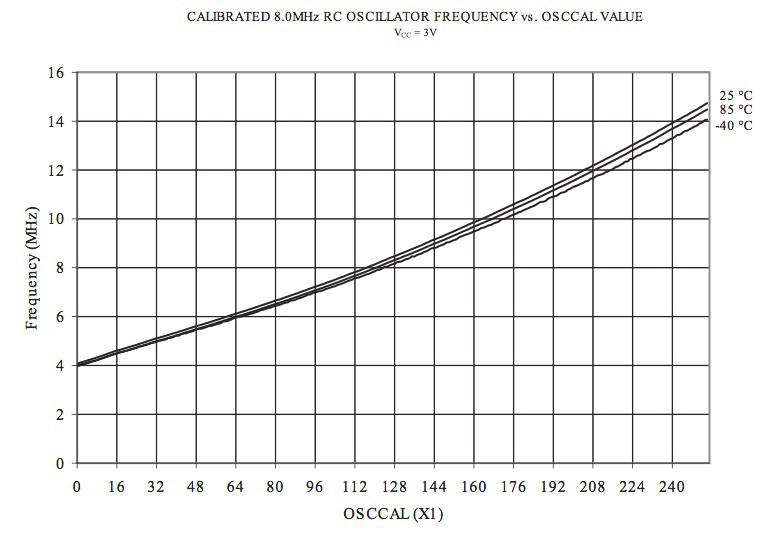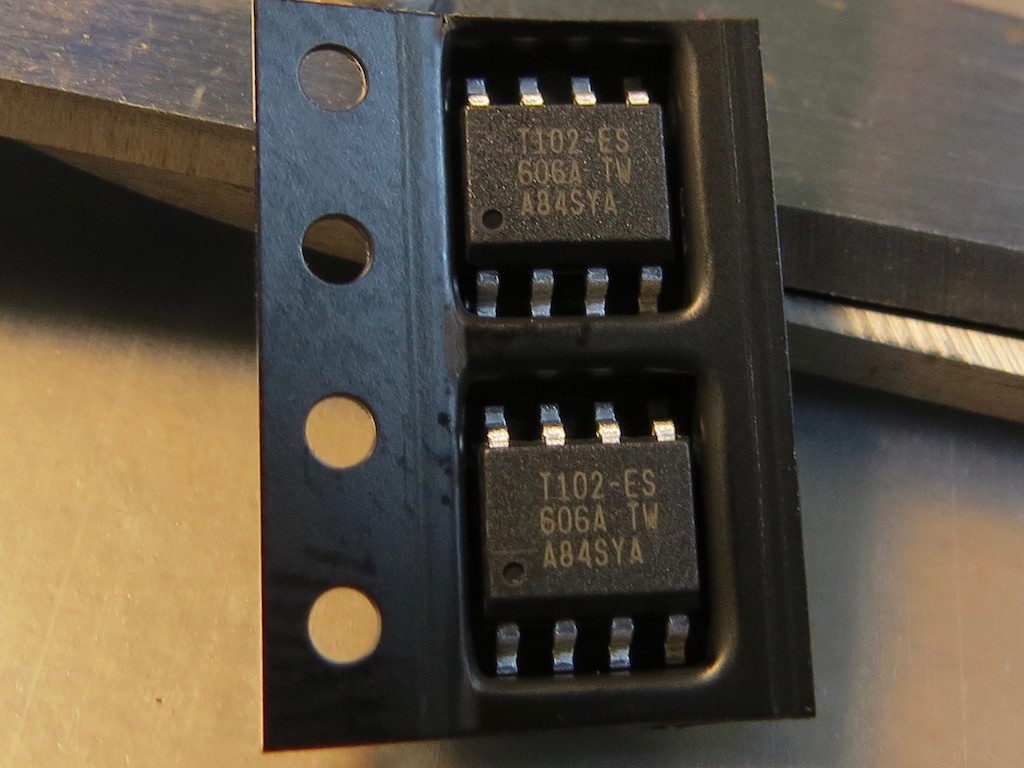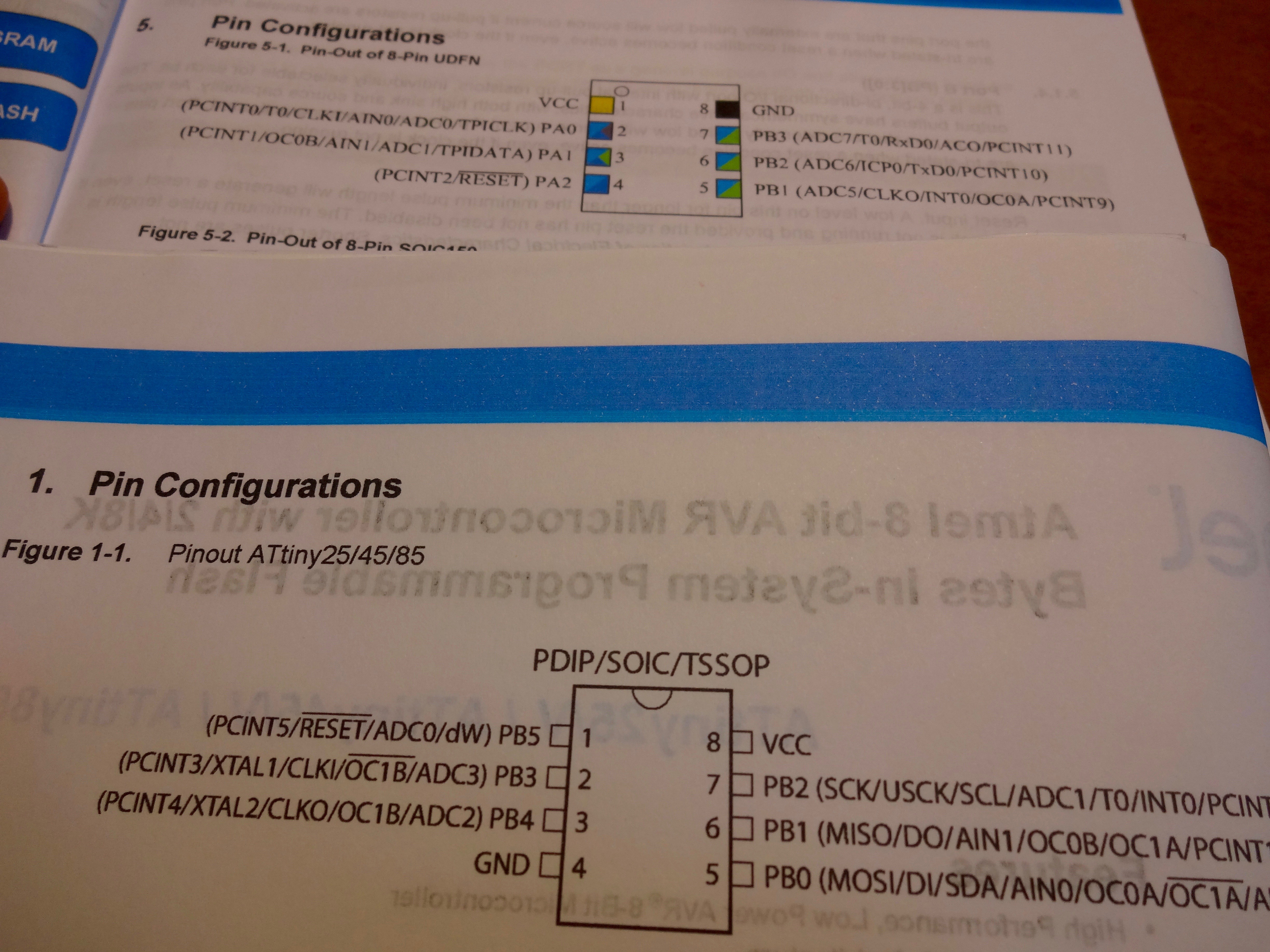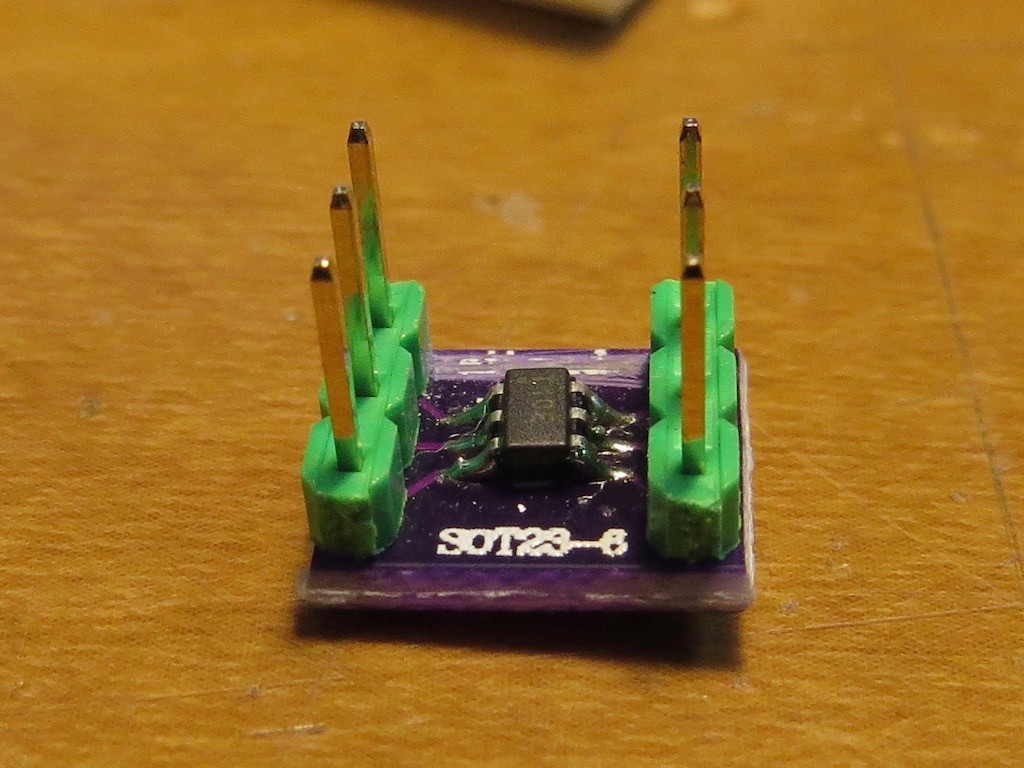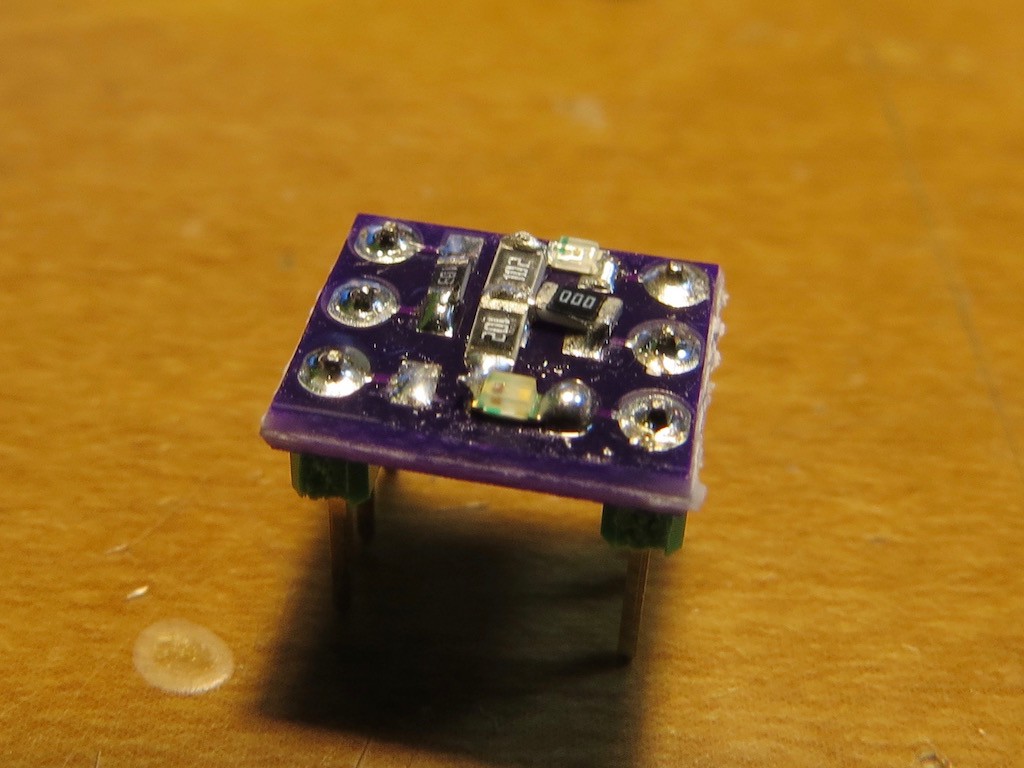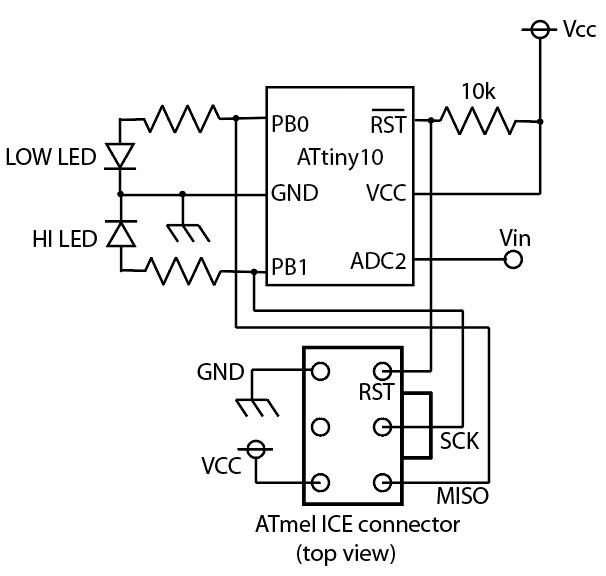-
Turning my page from ATtiny10 to new one
06/26/2016 at 13:16 • 0 comments![]()
As same as all of my previous creation, I myself feel I've almost fully utilise the function of tiny ATtiny10 SOT23-6 package and I completed "Super Tweezers" frequency and voltage measurement tweezers!
![]()
![]()
As I presented before, all of function is done by ultra tiny wonderful ATtiny10! I am not sure when is the next time but on the next time I will step forward from SOT23-6 to SOP8 or 14, a bit more larger scale one.
Actual operation can be found in the following movie... have fun!
-
Ultimate ? application of ATtiny10, freq counter & DVM just in one!
06/21/2016 at 12:54 • 0 comments![]()
I think it is quite close to "ultimate" application of tiny ATtiny10. Eventually two applications, frequency counter and digital volt meter is combined in just one code and its function can be switched by pushing switch ON or OFF as initial condition.
Here is the schematic. Still super simple and just added one switch for PB2. Indeed PB2 is working as (1) function selector, (2) frequency counter input, and (3) DVM meter input. Surely we can buy very high precision DVM and frequency counter but I'm myself a bit surprised to see my realisation just 50 cents SOT23-6 MCU. (The above schematic contains some unmounted components, for example IN4148 protection diode...)![]()
And my assembly code eventually ( already released at github) approaches to the limit of ATtiny10, 1024 bytes (1 kB)....
Segment Begin End Code Data Used Size Use% --------------------------------------------------------------- [.cseg] 0x000000 0x0003ae 942 0 942 1024 92.0% [.dseg] 0x000040 0x000060 0 0 0 32 0.0% [.eseg] 0x000000 0x000000 0 0 0 0 -Again it is dirty and not well organised but surely working as multi-function instrument. Actual operation can be found in the following movie... Have fun!! -
Eventually ATtiny10 becomes single chip frequency counter!!
06/19/2016 at 12:56 • 0 commentsWho said ATtiny10 is "brain dead" ? In its data sheet we cannot find word I2C but we can add function as same as LED blinking. In addition, ATtiny10 has one 16 bit timer which can be driven by external clock. Naturally it will work as "frequency counter!" Here we have!
![]()
Actually I had some accumulation of AVR assembly for these two months and this code is easily written after I2C bitbang completion.This is quick coding and not optimised but as same as before dirty code is released on github.
My code occupies on flash as,
"ATtiny10" memory use summary [bytes]: Segment Begin End Code Data Used Size Use% -------------------------------------------------------- [.cseg] 0x000000 0x000304 772 0 772 1024 [.dseg] 0x000040 0x000060 0 0 0 32 [.eseg] 0x000000 0x000000 0 0 0 0slightly decreased by "welcome message on LCD" deletion.... still 300 bytes free!Actual operation can be found in the following movie... Have fun and let us believe "Tiny" power!
-
ATtiny10 supporting I2C LCD and A/D leads to super simple V-meter
06/18/2016 at 03:52 • 0 commentsAs I presented in the previous log, I2C supporting in ATtiny10 seems to be successful. This time I activate A/D converter of ATtiny10. Indeed, ATtiny10 supporting I2C LCD and A/D leads to super simple Voltage meter!!
All you will need is ATtiny10 and I2C LCD. Nothing more. I made a assembly code, which contains lots of redundancy and non-nessesity part such as welcome message "Hello ATtiny10", and also voltage display part is NOT optimised yet but![]()
Segment Begin End Code Data Used Size Use% -------------------------------------------------------- [.cseg] 0x000000 0x00038c 908 0 908 1024 [.dseg] 0x000040 0x000060 0 0 0 32 [.eseg] 0x000000 0x000000 0 0 0 0it can be still inside internal flash of ATtiny10.My dirty assembly code is released on github and actual operation can be found in the following movie. Indeed response is well acceptable for voltage measurement application (main concern is accuracy, though...) Anyway, have fun! -
Bitbang of I2C on Attiny10
06/16/2016 at 11:00 • 2 commentsI2C interface is quite useful for extension of small MCU, because it just consume two pins (CLK and DAT). The case of Attiny10, it does not support by its hardware but indeed more than five years ago, some people and guys succeeded to implemented in C. For me, assembly seems to be more straightforward and I made the code from scratch.
![]()
Actually bitbang is a kind of "very fast LED blinking". If you can make LED blink program in some MCU, you will be able to implement I2C on it. For implementing it, for example, bit "1" and "0" coding is like this:
bit_high: ldi temp1, 0b00 out PORTB, temp1 rcall delay ldi temp1, 0b01 out PORTB, temp1 rcall delay ldi temp1, 0b11 out PORTB, temp1 rcall delay ldi temp1, 0b01 out PORTB, temp1 rcall delay ldi temp1, 0b00 out PORTB, temp1 rcall delay ret ;cl=1 da=0 bit_low: ldi temp1, 0b00 out PORTB, temp1 rcall delay ldi temp1, 0b00 out PORTB, temp1 rcall delay ldi temp1, 0b10 out PORTB, temp1 rcall delay ldi temp1, 0b00 out PORTB, temp1 rcall delay ldi temp1, 0b00 out PORTB, temp1 rcall delay retHere PB0 is SDA and PB1 is SCL of I2C. It is LED blinking, isn't it? If you have logic analyser (not expensive one but just a handy USB based analyser, in my case...) , actual timing and logic level can be confirmed and quite useful for completing bitbang.
This is the LCD display driven by bit banged Attiny10. Currently my assembly code occupies,![]()
Segment Begin End Code Data Used Size Use% -------------------------------------------------------- [.cseg] 0x000000 0x0001e6 486 0 486 1024 [.dseg] 0x000040 0x000060 0 0 0 32 [.eseg] 0x000000 0x000000 0 0 0 0Just 48% of flash and zero SRAM consumption yet (everything is processed in registers). My code (I am so sorry but it is quite dirty and redundant and no-sophisticted) is released on github, again it is combination of "LED blinking".Actual operation can be found in the following movie.. have fun!
-
Overclocking ATtiny10 !?
05/04/2016 at 08:47 • 0 commentsSo my lovely ATtiny10 is capable of processing lots job and at this moment, I have no complaint about its processing speed. But I noticed the default clock speed is 1MHz, internal RC oscillator (8MHz) divided by 8. This is no novelty but I would summarise how to set it to 8MHz and even beyond by OSCCAL register.
.def R_TEMP1, R16 ; setting clock divider change enable LDI R_TEMP1, 0xD8 OUT CCP, R_TEMP1 ; selecting internal 8MHz oscillator LDI R_TEMP1, 0x00 OUT CLKMSR, R_TEMP1 LDI R_TEMP1, 0xD8 OUT CCP, R_TEMP1 ; setting clock divider change enable LDI R_TEMP1, (0<<CLKPS3)+(0<<CLKPS2)+(0<<CLKPS1)+(0<<CLKPS0); OUT CLKPSR, R_TEMP1; set to 8MHz clock (disable div8)Just in order to change clock divider from 8 (default) to 1, these processes are required. Putting 0xD8 to CCP register is required each step of CLKMSR and CLKPSR. Just inserting these code, the clock will be set to 8MHz.
More another way to speed bump or up is usage of OSCCAL register. In data sheet, we can see
![]()
the clock speed varies from 4 MHz up to around 15 MHz. I was a bit afraid of this modification since it may forget original calibrated number for OSCCAL by touching it but the OSCCAL is restored if our code does not touch OSCCAL.
OSCCAL can be touched as follows.
LDI R_TEMP1, 0xFF ; overclock (from 4MHz(0x00) to 15 MHz(0xFF)) OUT OSCCAL, R_TEMP1If you need to recover to original calibrated state, just remove this code is enough....Actual operation can be found in the following movie (as an example by LED blinking..) Have fun!
-
Very short update: LED fade (not abrupt ON-OFF) by PWM at ATtiny10
04/10/2016 at 12:37 • 0 commentsI would put very short update, regarding my PWM trial
Corresponding ASM code is as follows. Indeed I greatly refer the C code at avrfreak and tried to convert to assembler by myself (so such a redundant code, ;-)
.def temp1 = R16 .def temp2 = R17 .def count_L = R18 .def count_H = R19 .def final_L = R20 .def final_H = R21 .def temp3 = R22 .def temp4 = R23 .def temp5 = R24 .def temp6 = R25 .equ topnum = 1000 .equ count_start = 0xff .equ count_end = 0x01 .equ subnum = 0x01 ; Replace with your application code setup: ldi temp1, (1<<PB0)+(1<<PB1); out DDRB, temp1 ldi temp1, (1<<COM0A1)+(1<<COM0B1)+(1<<WGM01); out TCCR0A, temp1 ldi temp1, low(topnum);1111101000 out ICR0L, temp1 ldi temp1, byte2(topnum) out ICR0H, temp1 ldi temp1,(1<<CS01)+(1<<WGM03)+(1<<WGM02) out TCCR0B, temp1 start: ;inc r16 ldi count_L, 0 ldi count_H, 0 ldi final_L, low(topnum) ldi final_H, byte2(topnum) ldi temp1, 0x01 ldi temp2, 0x00 loop1: add count_L, temp1 adc count_H, temp2 out OCR0AL, count_L out OCR0AH, count_H mov temp3, count_L mov temp4, count_H ldi temp5, low(topnum) ldi temp6, byte2(topnum) sub temp5,temp3 sbc temp6,temp4 out OCR0BL, temp5 out OCR0BH, temp6 rcall delay cp final_H, count_H cpc final_L, count_L brne loop1 rjmp start delay: ; subroutine DELAY ldi temp3, count_end ldi temp4, count_start ldi temp5, subnum counter: sub temp4, temp5 cpse temp4, temp3 rjmp counter retSomehow this code realise "soft LED blinking" as shown on the top... -
Very brief review of ATmel's new ATtiny 102
04/10/2016 at 09:20 • 4 comments![]()
Fortunately I got very recent ATmel MCU ATtiny102 and quickly tried to program RGB LED blinking through ATmel Studio. I found several differences from conventional 8-pin AVRs in every aspect.
(1) programming method is NOT SPI but TPI![]()
So far, 8-pin AVR was programmed by SPI (MOSI/MISO/CLK/RESET..) but this new 102 accept only TPI, which is same as ATtiny10.
(2) Pin assign is completely different!!!
As shown in the above picture ATtiny102 (up) has 1-pin VCC and 8-pin GND. This is totally different from conventional pin assign (which was totally pin compatible in 8-pin AVR series, ATtiny 13 to 85). We need a bit care for initial prototyping test.
(3) New 102 has two output ports PORTA and PORTB
I guess, ATmel uses same chip for 102 and 104 (simply most of ports are not wired in 102) and as a result 102 has two ports. This means, little source modification is required from conventional 8-pin AVR to 102.
(4) Additional voltage reference (1.1 V, 2.2 V, 4.3 V) for A/D converter
Voltage reference can be selected by REFS1 and REFS0 in ADMUX. Some ATtiny has 1.1 and 2.56 V reference but they has some limitation, requiring external capacitor. But the case of 102/104, it is completely free of charge.
(5) USART and USARTSPI (functions exclusive) supported
Not bit-banged but serial and SPI (one of them) are supported..
As for programming, ATmel Studio has already supported ATtiny102/104 and we don't need to wait for something.
Actual operation can be found in the following movie...
-
Joy in 1cm sq. board by ATtiny10
04/06/2016 at 11:47 • 0 commentsAnd I am trying even more smaller MCU, ATtiny 10, actually its size is identical to general switching transistor. But even in such a small package, it has 4ch 8bit A/D converter with 1024 words flash memory. 6pin is not enough to support full SPI writing but there is a special way, TPI (details can be found in websites) but we don't need to worry about TPI. ATmel Studio with Atmel ICE fully supports its programming.
![]()
Here is actual prototype board putting ATtiny10 for 6-pin dip break out. On the surface....
Two LEDs and resisters are put to organise "voltage indicator"![]()
![]()
This is a actual wiring information between ATtiny10 and ATmel ICE. MOSI has no connection but binary transfer is supported by Atmel Studio.
The following simple assembly code enables tiny voltage indicator...
.def r_temp1 = R16 .def r_temp2 = R17 .def r_temp3 = R18 .equ lv_1 = 0x40 ; values for voltage comparison .equ lv_2 = 0x80 .equ lv_3 = 0xC0 setup: ldi r_temp1, ((1<<ADEN)+(1<<ADSC)+(1<<ADATE)+(1<<ADIE)+(0<<ADIF)+(1<<ADPS2)+(1<<ADPS1)+(1<<ADPS2)) out ADCSRA,r_temp1 ;starting A/D conversion (free running mode) ldi r_temp1, ((1<<MUX1)+(0<<MUX0)) ; input A/D = PB2 out ADMUX,r_temp1 ; setting PB2 for A/D input ldi r_temp1, ((0<<DDB2)+(1<<DDB1)+(1<<DDB0)) ; PB0 and 1 are LED out out DDRB, r_temp1 ; PB0, 1 for LED output (PB2 for input) main: ; main loop start! in r_temp1,ADCL ;reading lower bit of A/D result cpi r_temp1, lv_1 ; comparing measured result with lv_1=0x2b brlo s_vchk_1 ; if the measured value is lower than 0x40, jump to s_vchk_10 cpi r_temp1, lv_2 ; comparing measured result with lv_2=0x80 brlo s_vchk_2 cpi r_temp1, lv_3 ; comparing measured result with lv_3=0xC0 brlo s_vchk_3 rjmp main ; closing main loop s_vchk_1: ldi r_temp3, 0x00 ;all LED are off (positive logic) out PORTB, r_temp3 ret ; return to main loop s_vchk_2: ldi r_temp3, 0b00001 ;PB0 is on out PORTB, r_temp3 ret ; return to main loop s_vchk_3: ldi r_temp3, 0b00011 ; PB0, 1 are on out PORTB, r_temp3 ret ; return to main loop"ATtiny10" memory use summary [bytes]: Segment Begin End Code Data Used Size Use% --------------------------------------------------------------- [.cseg] 0x000000 0x00002e 46 0 46 1024 4.5% [.dseg] 0x000040 0x000060 0 0 0 32 0.0% [.eseg] 0x000000 0x000000 0 0 0 0 - Assembly complete, 0 errors. 0 warningsAccording to Atmel Studio, Attiny10 is well enough to accommodate my short code and still has lots of room! (Seems just 4.5% of capacity is using...)Actual operation can be found in the following movie... have fun!
-
Very primitive voltage indicator by Attiny13
04/03/2016 at 07:11 • 0 commentsI am still in wonderful Attiny world, where I have learned lots of fundamentals of computer itself. This time I made a very simple and primitive voltage indicator by LEDs utilising A/D converter of ATtiny13.
![]()
As it is, ATtiny is 8-pin MCU and VCC, GND and RST ( I am still beginner, and cannot hand it away) total 3-pins are already occupied. So I used the rest 5 pins as, PB3 (pin 2) for A/D input and LEDs are driven by 4-pins by PB0, 1, 2, and 4. I am enjoying assembly language, since I can see and understand very fundamentals and the code is written by AVR assembly as follows.
; ; webADCattiny13.asm ; ; Created: 4/1/2016 12:52:26 PM ; Author : kodera2t ; .def r_temp1 = R16 .def r_temp2 = R17 .def r_temp3 = R18 .equ lv_1 = 0x2b ; values for voltage comparison .equ lv_2 = 0x56 .equ lv_3 = 0x81 .equ lv_4 = 0xac .equ lv_5 = 0xd7 setup: ldi r_temp1, ((1<<ADEN)+(1<<ADSC)+(1<<ADATE)+(1<<ADIE)+(0<<ADIF)+(1<<ADPS2)+(1<<ADPS1)+(1<<ADPS2)) out ADCSRA,r_temp1 ;starting A/D conversion ;(free running mode) ;ldi r_temp1, ((0<<REFS0)+(0<<ADLAR)+(1<<MUX1)+(1<<MUX0)) ;Vcc as analogue reference (currently commented out) ldi r_temp1, ((1<<REFS0)+(0<<ADLAR)+(1<<MUX1)+(1<<MUX0)) ;internal 1.1V as analogue reference out ADMUX,r_temp1 ; setting PB3 for A/D input ldi r_temp1, (1<<DDB4)+(0<<DDB3)+(1<<DDB2)+(1<<DDB1)+(1<<DDB0) out DDRB, r_temp1 ; PB0, 1, 2, 4 for LED output (PB3 for input) main: ; main loop start! in r_temp1,ADCL ;reading lower bit of A/D result in r_temp2,ADCH ;this program uses lower 8 bits only, therefore the comparing results will be periodical for input voltage variation cpi r_temp1, lv_1 ;comparing measured result with lv_1=0x2b brlo s_vchk_1 ; if the measured value is lower than 0x2b, jump to s_vchk_10 cpi r_temp1, lv_2 ;comparing measured result with lv_1=0x56 brlo s_vchk_2 cpi r_temp1, lv_3 ;comparing measured result with lv_1=0x81 brlo s_vchk_3 cpi r_temp1, lv_4 ;comparing measured result with lv_1=0xac brlo s_vchk_4 cpi r_temp1, lv_5 ;comparing measured result with lv_1=0xd7 brlo s_vchk_5 rjmp main ; closing main loop s_vchk_1: ldi r_temp3, 0b10111 ;all LED are off (negative logic) out PORTB, r_temp3 ret ; return to main loop s_vchk_2: ldi r_temp3, 0b10110 ;PB0 is on out PORTB, r_temp3 ret ; return to main loop s_vchk_3: ldi r_temp3, 0b10100 ; PB0, 1 are on out PORTB, r_temp3 ret ; return to main loop s_vchk_4: ldi r_temp3, 0b10000 ; PB0, 1, 2 are on out PORTB, r_temp3 ret ; return to main loop s_vchk_5: ldi r_temp3, 0b00000; all LED are on out PORTB, r_temp3 ret ; return to main loopThe generated hex file occupies 231 bytes in flash. We still have enough huge room in ATtiny13 !!!!! Actual operation can be found in the following movie... have fun!
Minimalist A-go-go
A project inside Attiny. I will not step out for larger one till I complete it.
 kodera2t
kodera2t